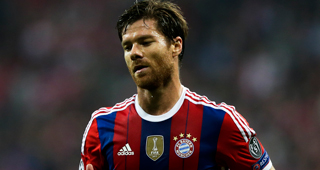It was just nine months ago when Chris Reina wrote on the newfound role of Xabi Alonso as both brain and engine of the Bayern Munich passing machine. The article described Peak Xabi Alonso, who averaged over 200 touches and 100 pass completions with 90% accuracy per match. So leave it to Pep Guardiola, who called Alonso the “worst player in the world” when it came to marking, to move his midfield general to center back to begin Bayern Munich’s 2015 season.
The move was brought upon as much by Bundesliga tactics and athleticism as much as Alonso’s ability to make up distance through his devastating long passes. And as Bayern Munich ended last season with foundational players Bastian Schweinsteiger, Franck Ribery, Arjen Robben, Alonso himself all over 30 years old, with another dominant league run followed by a disappointing European campaign, there was a question as to what Guardiola would do this summer to reinvigorate the squad - especially in light of Borussia Dortmund hiring Thomas Tuchel.
The signings of Douglas Costa, Arturo Vidal and Kingsley Coman signaled an intent of directness. Costa has been Bayern’s best creator through the first four matches (Alonso says his role is to put Costa in position to assist Robert Lewandoski or Thomas Muller, which has been a effective sequence as we’ll see below). Vidal is arguably the best box to box midfielder on the planet, and a player who, according to Jerome Boateng, added a much needed edge to training. Coman is still 19, but has the directness and speed to one day replace Ribery. But to make the newfound dynamism and directness fit, Guardiola first moved Xabi Alonso to center back.
The time Alonso was allotted with possession further back provided immediate dividends, with Alonso providing his signature diagonal ball that lead to Bayern Munich’s second goal against Hamburg. Down 1-0 in their next match against Hoffenheim, Alonso hit a diagonal to Costa, who then assisted Muller’s game tying goal. Their first goal against uber-pressers Leverkusen in their third match featured the same three characters: an Alonso diagonal to Costa on the wing, Costa beating a defender, and Muller scoring a goal. Finally, Bayern were tied 1-1 against Augsburg last weekend, when a variation of the sequence, featuring the three same characters, appeared again: an Alonso diagonal, Costa getting a penalty, and Muller converting. Four matches, four Alonso long passes that lead to goals, and 12 points.
Many have pointed out the tactical poetry of Guardiola moving from a four man backline that morphed into a three man backline when in possession, to his now three man backline that becomes a four man backline in possession. His vast ideas were bound to find its way full circle somehow. This time, the final output of Alonso finding Costa in space, on the wing, bypassing an entire press with one pass, could be the sequence that finally unlocks Europe for Guardiola’s side.
------
But, as Chris Reina’s article also points out, there’s a question as to where Alonso fits in the Champions League stage at age 33, especially when they face a fit, athletic side like Real Madrid. Alex Lawrence of Miasanrot described Alonso’s inefficient positioning as vulnerable to the press, especially compared to his “press resistant” teammate Thiago. Alonso indeed had his poorest performance of last season in the first leg loss against FC Porto in the Champions League, getting dispossessed in front of his own goal by a hard press at least twice.
As tactics evolve, it makes intuitive sense that the gegenpress-breaker would be an accurate long switching play, and bypassing the outnumbered attack. It’s what Adin Osman meant when he wrote that Bayern Munich’s 3-0 win against Leverkusen was the first time that Guardiola “finally beat” Schmidt in that he didn’t just beat Leverkusen, he found a way to beat the pressing system.
The best Champions League sides, including Bayern’s counterparts in Group F, will be much savvier in their pressing than Leverkusen’s all out style. Regardless, Bayern are as well equipped as they’ve ever been under Guardiola to handle Europe’s best. Perhaps not in terms of technique or passing, but certainly in physicality and athleticism. Vidal can handle the battling duties in midfield. Costa, Robben, and Coman can match any defender’s pace on the wing. Robert Lewandoski looks to finally be fulfilling his potential under Guardiola. But Alonso must still be able to find the time and space to make it all tick. Yet they may have discovered a blueprint, however, a sequence, to take advantage of their opponent’s aggression.
False nines. Center backs who hold possession on the wing. Right backs who play as center midfielders. Midfielders built to exploit half spaces. Guardiola has imagined, and realized almost everything in his time at Bayern Munich. So in another irony, it’s his oldest player with the most traditional skill set in the starting eleven, the one never known for his running or pressing, that holds the key to the one accomplishment that has eluded him. But there may be more to it. If Bayern Munich find Champions League success this season, through the right foot of center back Xabi Alonso, it won’t only end in a trophy, but perhaps signal a new direction in soccer tactics - the counter to the counter-press.



